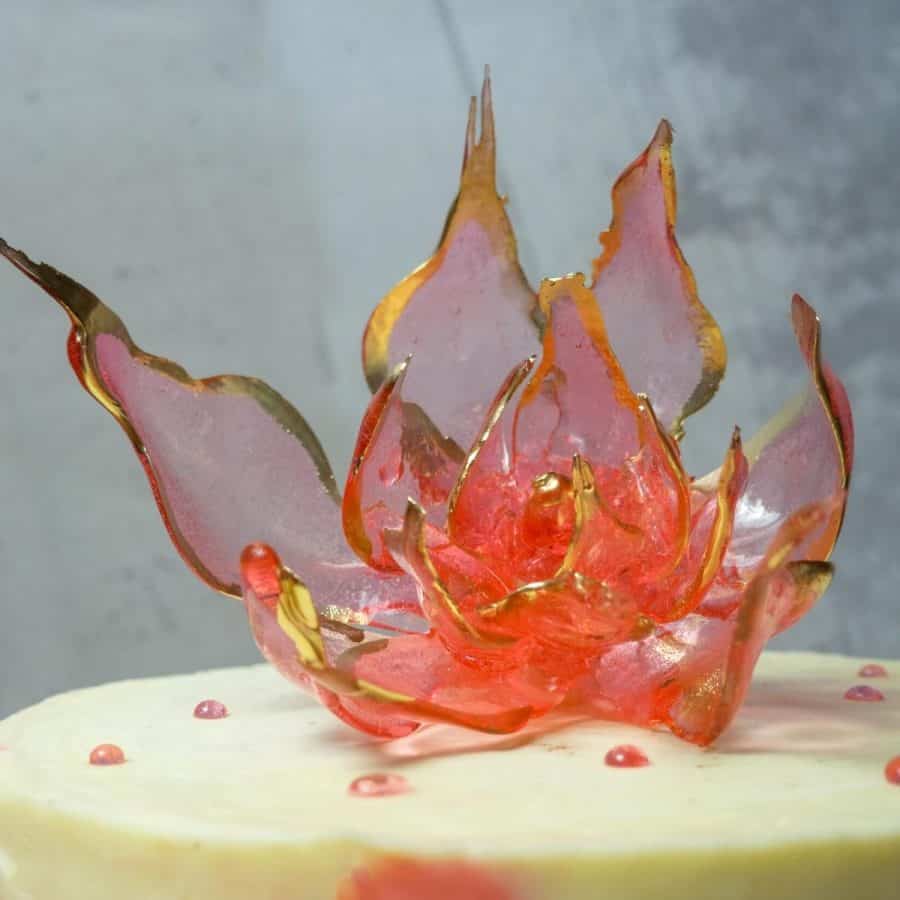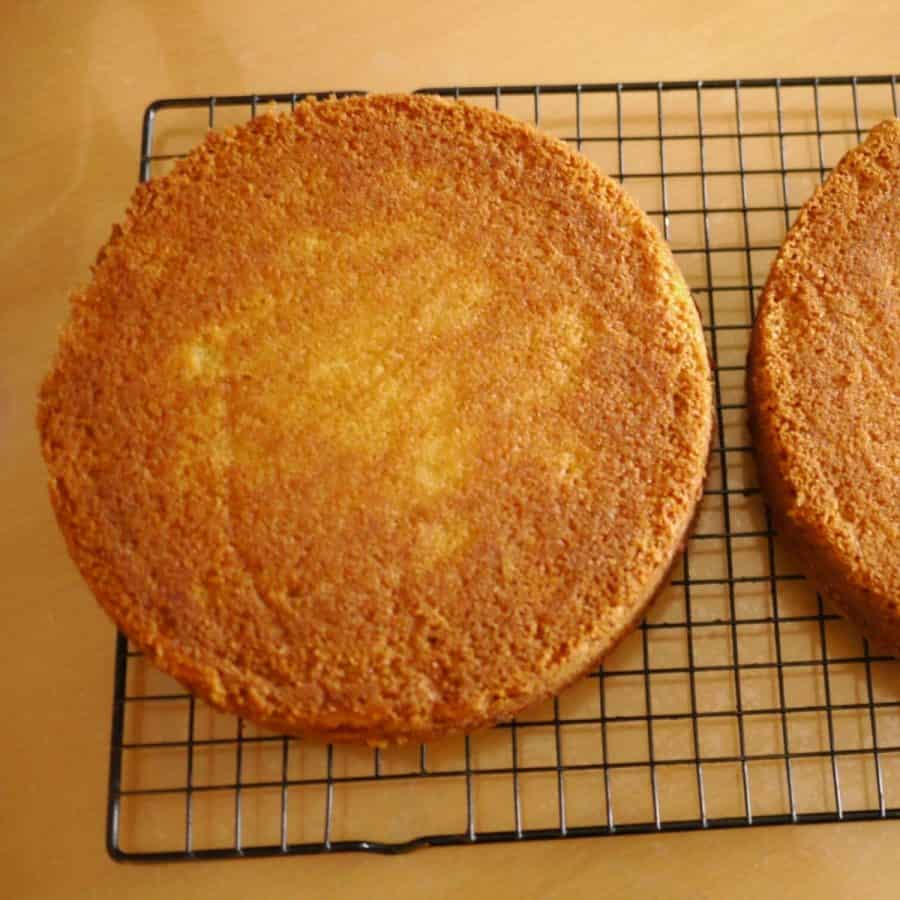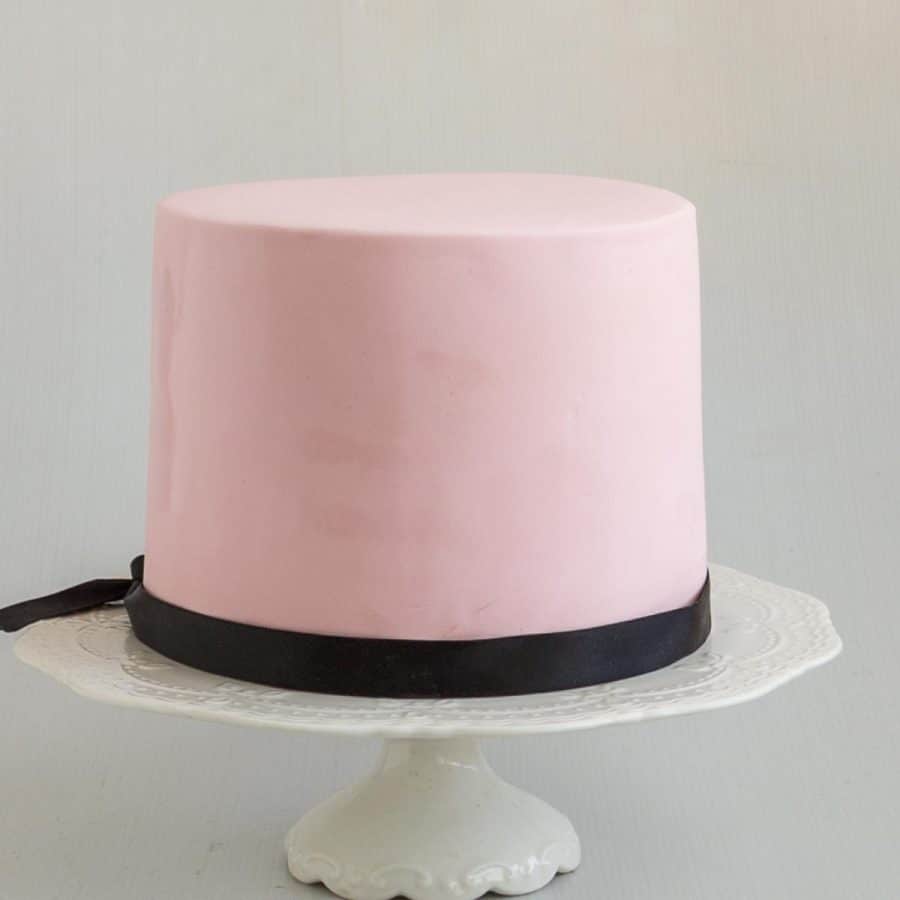While my homemade Fondant recipe is very popular, it also contains gelatin. Thus, it’s unsuitable for people who are vegetarian. And, I also have tons of people requesting how to change or substitute it to vegetarian fondant. So, of course, I had to go and figure out how it would work out without gelatin. So, finally I did test my recipe and am happy to say this is what works best for the vegetarian version of the fondant. In fact, this recipe is basically adapted from my homemade fondant recipe. And, as you can see, most of the ingredients are the same with changes only made to the amounts. So, try and keep the amounts mentioned in this recipe accurate. Below, is the cake I made with this vegetarian fondant. I did not take any progress pictures because the method is exactly the same as my Homemade Fondant recipe. This is vegetarian seaweed-based gelatin that comes in powder form. And, it works quite the same as gelatin. However, there are different qualities in the market, some better than others. So keep that in mind. And, those of you in India, can also get agar-agar in the form of China grass. I think that’s what the term is. In fact, it is agar-agar but very diluted and does not set in the same manner. So, if you use it you may find that the fondant is less stretch or elastic.
Ingredients and substitutes
Water – Water is the easiest to dissolve agar-agar. Having said that, I often use fresh cream (just like my homemade fondant recipe). And yet, not everyone seems to have success using fresh cream to dissolve agar agar. So, to keep things easy – let’s just do water. Light corn syrup – Can be found in any cake decorating store. And, if you cannot find light corn syrup, you can also use glucose. Use the same quantity the only difference is glucose is thicker than light corn syrup. That’s ok. Agar Agar – You can also use 1 tbsp of vegetarian gelatin instead. I made a special note about agar-agar – please read above. Glycerin – Please use only edible glycerin found at most cake decorating stores or pharmacy. Clear vanilla – The purpose of clear vanilla is to maintain the white color of the fondant. And, if you cannot find clear vanilla, you can also use rose extract or almond extract. Powdered sugar – Also called confectioners sugar or icing sugar. I highly recommend using powdered sugar made with cane sugar, not beet sugar. Since, beet sugar has a tendency to be very grainy.So, make sure you do not have lumps in your powder sugar. And, if necessary sift the sugar.
Step-by-step: Vegetarian fondant recipe
Wet ingredients: Dissolve Agar Agar in water and let it sit for 5 minutes. Add light corn syrup to the soaked agar-agar. Place on the stovetop on medium-low heat (it takes time but will dissolve). Stir continuously until well dissolved. Add the glycerin.Note: Keep the heat to medium-low, or the water will evaporate. If the mixture becomes too thick, add a few tablespoons of water. Combine: Prepare a large bowl and add half the powdered sugar. Make a hollow in the center, ready for our agar-agar mixture. While still warm and liquid, immediately pour the mixture into the bowl with powdered sugar.Pro tip – if the agar-agar is not entirely dissolved – pour the mixture through a sieve so you won’t have grains in the finished product Knead: Use a wooden spoon to combine the powdered sugar and liquid. Then knead with your hand, adding powdered sugar to make a pliable dough. Also, add the tylose powder and knead it in. You want it to be pliable but not sticky and stiff. You can also add more powdered sugar later.Pro tip: Do not add too much powdered sugar; the fondant will firm as it rests in the fridge. Use vegetable shortening to knead. Rest: Divide the mixture into two portions and place them in a Ziploc bag. Place these Ziploc bags in a plastic container to prevent drying. Let rest in the fridge for a couple of hours or overnight. Usage: Leave the fondant for a few hours to bring it to room temperature. Once set, it can be stored at room temperature (see storage). If the fondant is too stiff – a 5-second burst in the microwave works great.
Tips for Success
Choose the Right Ingredients: Use plant-based alternatives such as agar-agar or carrageenan instead of gelatin. These ingredients will help achieve the right texture without compromising your vegetarian principles. Use Quality Glycerin: Ensure that the glycerin you use is vegetable-derived. This helps in making the fondant smooth and pliable. Incorporate Colors Early: If you’re adding color to your fondant, incorporate the food coloring early in the mixing process to ensure even distribution and a vibrant hue. Adjust Consistency Carefully: If the fondant is too soft, gradually add more powdered sugar. If it’s too stiff, add a small amount of water or vegetable shortening to achieve the perfect consistency. Knead Thoroughly: Properly kneading the fondant helps in developing a smooth texture. Knead until the fondant is pliable and free from lumps. Rest the Fondant: Allow the fondant to rest overnight. This helps the flavors meld and the texture to stabilize, making it easier to work with. Use Cornstarch or Powdered Sugar for Rolling: Prevent sticking by using cornstarch or powdered sugar on your work surface and rolling pin. This helps in rolling out the fondant smoothly. Store Properly: Wrap the fondant tightly in plastic wrap and store it in an airtight container at room temperature. This prevents it from drying out and ensures it stays pliable. Avoid Overworking: Don’t overwork the fondant, as it can become dry and cracked. Handle it just enough to get it smooth and ready to use. Test Before Application: Before covering a cake, test a small piece of fondant to ensure it rolls out smoothly and covers well without tearing.
Troubleshooting
My rolled fondant is cracking when rolled? Often the issue here is that too much-powdered sugar has been added. Why is my rolled fondant tearing on the cake? Fondant needs to be rolled between 1/4″ to 1/8″ thick. In fact, 1/4″ is too thick. And, it can cause the fondant to break with its own weight. And, 1/8″ is thin and can cause the fondant to tear as you stretch it. However, finding that right thickness that works for you comes with practice, so don’t give up. My homemade fondant is too sticky? If you are making homemade fondant and the fondant is still too sticky – you probably need more fondant. And, if you live in a hot humid place and over-knead the fondant it can also become sticky. In this case, you need to let the fondant rest and then roll again later. Or place in the fridge until it cools off a bit. My fondant is too hard what can I do? First, thaw the fondant in the fridge for 10 seconds so you can knead it. Then, add a teaspoon or two of glycerin to help soften it. Next, add vegetable shortening and knead it some more. And, if this still does not work, its best to use this fondant for decorative purposes and decorations. Then, make a fresh batch for covering the cake.
Storage
Regular fondant can last for months if kept properly. In fact, the high quantity of powdered sugar works as a preservative. Also, this fondant can stay at room temperature for about a month on the counter. I usually portion mine into 1 kg / 2-pound bags.Having said that, in the interest of safety If you are not using your fondant it’s best to keep it in the fridge rather than on the counter especially in summer months. If you have hot and humid weather it’s best to keep the fondant in the fridge if not using for a few days just to be safe and ensure good preservation. You can also place them in the fridge for up to 3 months. If you need to keep it longer store it in the freezer. Thaw it in the fridge Just take it out a couple of hours or the night before you need it. Being a cake decorator my fondant doesn’t usually stay long. I make a couple of batches in one month. So if you do have any information to share please put a comment at the bottom of this post so it will help the other users.
How do you color homemade rolled fondant
Being a cake decorator, I have tons of posts related to fondant, including tutorials. So I won’t bore you by repeating myself. Therefore, I shared two detailed posts one was 14 must-know tips for working with fondant and the other being How to color fondant. In addition, I’ll also give you a few important tips here.
Always use edible food color gels for coloring fondant. Because they will not make your fondant softer in consistency since they are very concentrated in color. And if you don’t have food color gels – you can also use liquid color at the beginning of the recipe while reducing the original quantity of liquid in the recipe. Food color gels will intensify over time. So if you color it ahead of time – make it one shade lighter and keep it for a few days. That way you won’t have to add more white or use too much color gel. Also, color gels can dye your hands. So it’s best to use gloves when coloring fondant. In addition, rubbing veg shortening on your gloved hands also helps. Personally, I find that working with gloves is not easy, especially with sticky fondant. So, I work with fondant by just rubbing my hand with vegetable shortening, and then washing them clean with a cream-based detergent.
How much fondant do I need for my cake?
The chart below is based on 4 inch tall cakes. For shorter height you will need less and tall cakes will obviously need more. Having said that, this presumes rolling fondant closer to 1/8″ thickness. If you roll fondant too thick closer to 1/4″ inch thick you will need more.
See all Fondant recipes Best EVER Homemade Fondant Homemade Chocolate Fondant from Scratch Perfect Homemade Black Fondant Recipe Chocolate Marshmallow Fondant Best Homemade Marshmallow Fondant
Frequently asked questions
Did you LIKE this recipe? Save it for later. You can find my recipes on Pinterest. Follow me on Facebook, Twitter, and Instagram.Subscribe, and I’ll send you new recipes right to your inbox. Thank you for sharing - Save for later





















